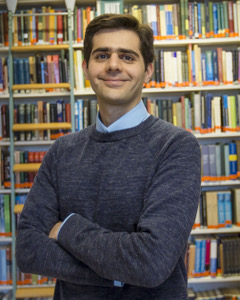Amin Doostmohammadi is awarded NERD Grant from the Novo Nordisk Foundation
 Novo Nordisk Foundation Assistant Professor Amin Doostmoohammadi has just received a large grant from the Novo Nordisk Foundation under their NERD program. Understanding how cells sense, react, and interact with each other and with their environment is a question at the forefront of current research in developmental biology and biomedicine. Amin Doostmohammadi and his team at NBIA will focus on the less-studied, yet biologically significant, mechanical aspects of this problem; they will explore a novel form of cellular sensing and communication that Amin has dubbed “Topography-Mediated Cellular Self-Organization (TopoMed)”. Here, cells autonomously and actively exploit folding and topographical restructuring of their underlying substrates as a means of self-induced guidance and communication mechanism to coordinate their individual and collective behaviors.
Novo Nordisk Foundation Assistant Professor Amin Doostmoohammadi has just received a large grant from the Novo Nordisk Foundation under their NERD program. Understanding how cells sense, react, and interact with each other and with their environment is a question at the forefront of current research in developmental biology and biomedicine. Amin Doostmohammadi and his team at NBIA will focus on the less-studied, yet biologically significant, mechanical aspects of this problem; they will explore a novel form of cellular sensing and communication that Amin has dubbed “Topography-Mediated Cellular Self-Organization (TopoMed)”. Here, cells autonomously and actively exploit folding and topographical restructuring of their underlying substrates as a means of self-induced guidance and communication mechanism to coordinate their individual and collective behaviors.
Deciphering this complex cell-topography coupling necessitates detailed knowledge of the cellular force generation machinery, in parallel with mechanism of force transmission and substrate deformation. The team plans to take a systematic bottom-up approach, starting with understanding the details of single cell-induced folding of substrate, moving up to cell-cell interactions mediated by surface topography, and culminating in collective self-guidance in multicellular assemblies. Importantly, rapidly expanding body of evidence is establishing that cells sense and respond to the dynamic changes in Extracellular Matrix (ECM) structure, challenging the current stiffness-centric view of cell–matrix mechanosensing. TopoMed will reveal whether dynamically changing surface topography has been a hidden variable that, more broadly, could shed light on much past work in the study of soft biomaterials in biology.
The work is expected to deliver a powerful, state-of-the-art, predictive framework to simulate multicellular self-organization on compliant substrates, to help engineer novel biomaterials for repair and regeneration of cellular tissues, for example in soft hydrogel therapies for enhancing wound healing process in vivo, and to provide exciting inspiration for previously inconceivable biomimetic designs.
